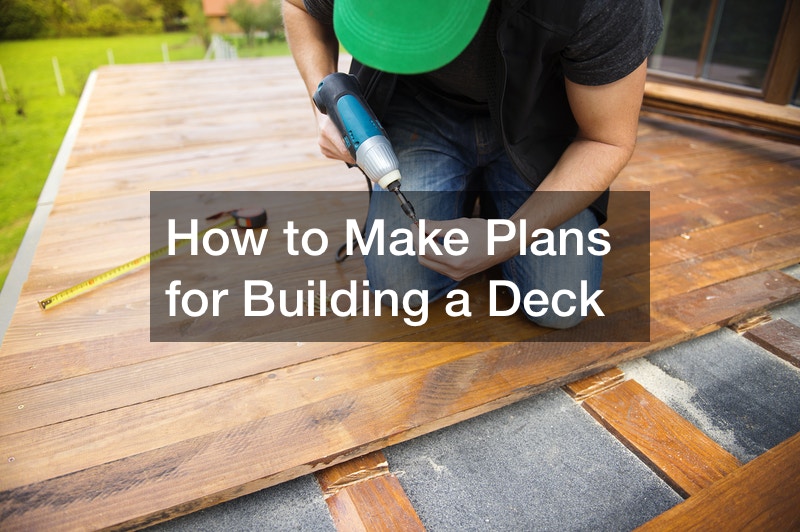
If you have decided to build a deck for your home, this is usually a great idea for so many reasons. For one, having a deck helps you expand your entertaining space, meaning you can entertain more people and have fun without feeling like the space is too cramped. A deck is also an easier option if you want to avoid extensive renovations while also boosting the value of your home. That said, if you want to make the most of your project, it’s a good idea to outline plans for building a deck, so you know exactly what’s expected of the project. Read on to discover tips to consider when making plans for building a deck.
Understand How Decks Are Put Together
One of the first things to consider when making plans for building a deck is how all the different components of a deck come together. This is important if you want to build a sturdy deck that won’t require building restoration down the line. There are many components of a deck that you need to be aware of, such as the footings, which are required to hold up the posts. In turn, the posts are important because they ensure good airflow and access to the under-deck area. You also have the beams, which act as the main structural support, and the joist, which creates a solid framework to support the deck boards.
Other major components include the deck boards, which are the part that you walk on, or the flooring of your deck. Your deck will also require a drainage system to allow easy shedding of water, a railing to provide a sense of security, and to enhance the architectural style of your deck, as well as stairs to enable access to your deck. As you can see, the average deck comprises many components, and knowing how a deck is structured can pave the way for better planning and building.
Figure Out the Best Deck Placement
Wondering where to place your deck? It’s common to place the deck off of the living room or kitchen, but before you make the final decision, there are a few considerations you may need to make. For starters, how much privacy do you prefer when lounging on your deck? If privacy is important, then you should consider building your deck off the back of your home, where you’re more likely to find a private spot. You could also consider installing a privacy screen to create more privacy around your deck. Another consideration to make when determining the placement of the deck is the amount of sunlight you would like to get.
Depending on the weather, you might prefer a warm spot that gets plenty of sunshine or somewhere that gets a lot of shade to protect yourself from the heat. You also want to ensure the deck is as close to the house as possible for ease of access. If your property has scenic views, you might want to take this into account, so you should take advantage of the beautiful scenery. In addition, if you have trees on your property, you can opt for tree removal or have them incorporated into the design. Regardless of where you choose to place your deck, make sure it blends well with the rest of the landscaping instead of sticking out like a sore thumb.
Determine Deck Shape and Size

Your plans for building a deck should also include the deck shape and size. That’s because the shape and size of the deck determine how coordinated the end result will look. Ideally, the size and shape of your deck should complement the size and shape of your yard. This allows you to make the most of the available space. In addition, it’s also important to factor in the style and proportions of your home. Also, keep in mind that adding a deck changes the exterior shape and size of your home, so it’s important to choose proportions that align with your home. More specifically, if you want to choose the best size for your deck, the first and crucial thing to do is to determine all the activities you plan to do on your deck.
If you’re going to be hosting and entertaining a lot, then you need plenty of space for cookouts and seating. If you have already picked out furniture for your deck, check the dimensions to make sure that everything will fit properly. When choosing the best shape and style for your deck, consider which shape gives you the most visual focus. It also helps to choose a deck that matches the architectural style of your home, depending on whether you have a traditional or contemporary home.
Consider the Pros and Cons of DIY Vs. Hiring a Contractor
One thing that will majorly influence your plans for building a deck is whether to hire deck builders or do-it-yourself. There are several things you need to consider to make the right decision and ensure a quality deck installation. The most important thing to consider is the level of expertise you have. While you may be tempted to save money by not hiring deck builders, ending up with a poorly built deck can cost you down the line.
In addition, you want to avoid a deck-building project that lasts longer when there’s a better option of hiring a professional deck contractor who can do a better and faster job than you can. DIY can be exciting when you have the time and tools, but if you haven’t built a deck before, you can’t always be aware of all the little things that could go wrong. Even if you have the time, it might also take time to understand the fundamentals of construction. To strike the right balance, you can opt to DIY the simple tasks and leave the rest to the professionals.
Choose The Right Deck Material

There are different types of decking material that you can choose from, and you can only determine the best option by weighing the pros and cons of each option. Your list of options typically includes pressure-treated lumber, natural woods, and composites. Pressure-treated lumber is made of natural wood, but it has had chemicals applied to make it resistant to bugs, rot, and other damaging elements.
Most people prefer it because it’s also affordable. When choosing from natural woods that have not been chemically treated, you are usually better off choosing options like redwood and red cedar. If you want a more versatile option, composites are a better option. They’re made from wood fiber and plastic and can be highly durable. Other options include PVC and aluminum.
Work Out Your Budget
Your budget will determine virtually every aspect of your plans for building a deck. Building a deck can be relatively inexpensive or costly, depending on several factors. The cost of adding a deck to your home is typically affected by where you live, the size of your deck, the materials you use, and other add-ons you might prefer. If you’re also focused on creating a pathway that leads to your deck, then you also have to factor in the cost of asphalt paving installation and hiring an asphalt contractor. In any case, knowing the cost of your deck in advance will help you manage your budget so that building a new deck will not upset your finances.
Do Your Research to Stay Compliant
Before you get ready to build that new deck, keep in mind that it’s not only about what you want, but it’s also about what the law wants. This is especially true if you’re building a larger deck. In most states, building a patio doesn’t typically require one to have a permit. However, most decks are larger structures, so it’s necessary to comply with applicable regulations at the state, city, or municipality level. The last thing you want is to complete your structure only to face headaches when you realize that the design doesn’t align with the laws and permits for outdoor decking that apply to your location.
Since these laws and permits vary from area to area, the best way to know what’s required of you is to visit your local building department. Even if you have hired a contractor, it’s usually your duty as a homeowner to verify if and when a permit is required. So you need to take the time to research the type of permit you need and what you need to do to secure the necessary approvals. Besides checking what your state, city, or local municipality requires, it’s also necessary to check whether your HOA (if you are part of one) regulates additions and structures that may affect the overall appearance of the neighborhood you live in.
Make Sure You Have the Tools You’ll Need

If you’re making DIY plans for building a deck, you’ll need to collect the right tools for the project. The good news is that building a deck won’t require any complicated tools. In fact, if you have already completed many DIY projects, you should have the right tools in your home. In case you need some power tools, consider renting them instead of purchasing them, especially if you are to use them only for your deck. There are various tools that you typically need for deck construction. The list includes tools for layout and measuring, tools for excavation and general work, fastening tools, and tools for shaping and smoothing.
Tools for layout and measuring are needed to ensure that you build a deck with high precision. For instance, you’ll need a tape measure, chalk lines, framing, and speed squares to create perfectly straight lines, checking corners, and marking boards before cutting. Excavation tools like shovels or a clamshell post hole digger are handy when you need to dig the earth and remove the soil. You also need tools for cutting, such as a circular saw, jigsaw, table saw, knives, shears, and chop saw. Fastening tools include a hammer, power nailer, or a nail gun with compressor, while items like a belt sander or hand sander will help you smoothen sharp edges and customize the design of your deck.
Create a Checklist for Things to Do

You don’t have to get carried away making plans for building a deck. The whole idea is to have general guidelines for what to do to stay on track with your deck. Once you have made your plans, you’ll also need to create a checklist that you can continually refer to as your project progresses. Having a ready-made checklist that you can consult at a moment’s notice is one of the easiest ways to ensure that your deck doesn’t fail. Be sure to include key items in your checklist that are necessary for the success of your deck-building project.
For instance, your checklist should include flashing, which is required to protect the support frame of your deck and keep it strong. Adding flashing to the deck’s joints will help the structural components last longer. You can also add other things like joist hangers, concrete deck blocks, and cement piers, depending on your deck building needs. Joist hangers make your structure more durable by adding structural steel, while concrete deck blocks are ideal if your structure is closer to the ground. If you have a higher deck, then you might consider using cement piers to support the weight of your deck. When you have the right checklist, it’s possible to create a solid deck that you can enjoy for many years to come.
Now that you have your plans for building a deck in order, it’s time to turn your vision into reality. The good thing is the end result is more likely to be exceptional since you put some thought into it and didn’t just dive headfirst into the process. When you have decided to build a deck, most of the significant work goes into making plans to build the structure. Admittedly, building a deck takes some work, but you can streamline the process by investing more time and effort in making the perfect plans for building a deck. We hope you enjoy the process of turning your deck-building plans into reality!




